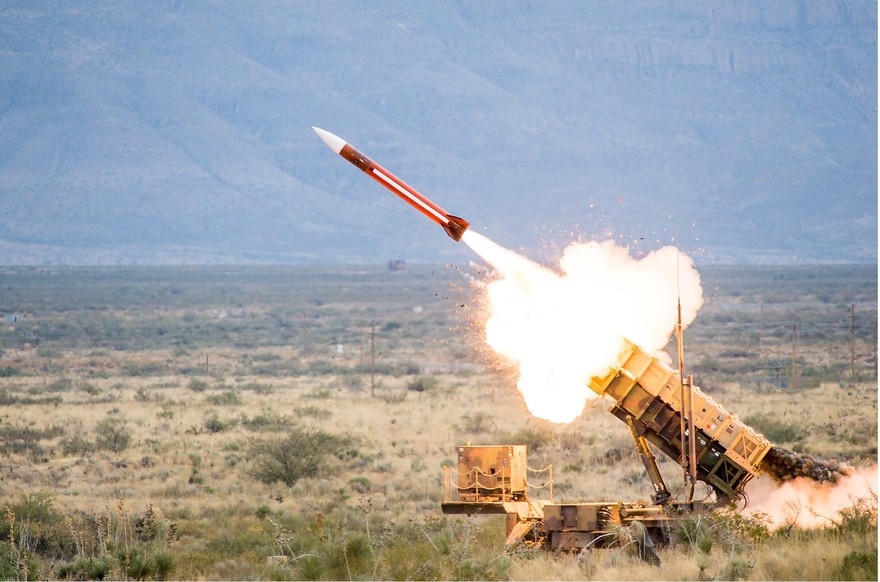Defense companies get the bulk of their revenue from one customer -- the U.S. government. Fortunately, that customer has deep pockets and a long history of paying its bills. The federal government’s stability gives defense companies and investors some predictability when it comes to managing cash and projecting growth.

Companies in the defense sector offer a wide range of products and services to their main customer, and some are better investments than others. Here's what you need to know about investing in the defense sector and how to pick where your money should go.
Top 8 defense stocks to buy in 2025
Company | Defense Focus |
|---|---|
Lockheed Martin (NYSE:LMT) | Aviation, space, missiles |
Boeing (NYSE:BA) | Aircraft, space, helicopters |
Northrop Grumman (NYSE:NOC) | Nuclear efforts, bombers, space |
General Dynamics (NYSE:GD) | Shipbuilding, defense IT, tanks |
RTX (NYSE:RTX) | Electronics, missiles, aerospace components |
Leidos Holdings (NYSE:LDOS) | Defense IT, space |
L3Harris Technologies (NYSE:LHX) | Space, electronics, communications equipment |
AeroVironment (NASDAQ:AVAV) | Drones, space |
Let's look closer at these standout companies.
1. Lockheed Martin

NYSE: LMT
Key Data Points
Lockheed Martin (LMT +0.66%) is the world's largest defense company and the U.S. government's biggest contractor. It's also the lead contractor on the F-35 Joint Strike Fighter, the world's most expensive airplane.
Lockheed's legendary Skunk Works research facility in California is world-renowned. The company has leveraged its research muscle to become a leader in advanced fighter planes, high-tech missiles, and cutting-edge electronics.
2. Boeing

NYSE: BA
Key Data Points
Boeing (BA +0.60%) is best known for its commercial airplanes, but its defense business -- although accounting for just one-third of total company revenue -- is large enough to rank among the industry's titans. Boeing makes several aircraft and helicopters for the Pentagon and is involved in space pursuits. The company's defense business has also branched out into autonomous submarines and other products.
Boeing has been a tough stock to own since the beginning of the decade, and the shares are still about 50% less than their 2019 high. Troubles remain on the commercial side of Boeing, but the company remains an important vendor to the U.S. government. If Boeing can successfully work through the operational troubles that have plagued it, there is a lot of upside potential for the stock.
3. Northrop Grumman

NYSE: NOC
Key Data Points
Northrop Grumman (NOC +0.40%) is responsible for stealth bombers and has a large space portfolio. The company is closely tied to the nuclear triad -- a combination of nuclear missiles, bombers, and submarines able to strike back if the nation is attacked.
Northrop is the second-largest stand-alone defense contractor, and in years past would sometimes be overlooked in favor of Lockheed Martin. But Northrop Grumman's portfolio is more closely tied to key Pentagon priorities, including the triad, making it a good option for investors seeking predictable growth in the years to come.
4. General Dynamics

NYSE: GD
Key Data Points
General Dynamics (GD +0.45%) is one of two primary military shipbuilders and has a portfolio of tanks and land vehicles, making it one of the go-to vendors for the U.S. Army. General Dynamics also has one of the largest defense-focused IT and services businesses, giving it some revenue stability at times when the Pentagon cuts back on equipment purchases.
Ship construction is complex, and individual vessels can take years to complete, creating some quarter-to-quarter revenue inconsistency. General Dynamics tries to offset that choppiness via its more-predictable IT business, but investors should be aware that the mix of businesses can make it difficult to predict quarterly results.
5. RTX

NYSE: RTX
Key Data Points
RTX (RTX +0.43%), formerly Raytheon Technologies, doesn't make warships or fighters. However, it does have a role in a wide range of important military platforms led by other contractors. It is the product of the 2020 merger between Raytheon, a defense electronics and missile specialist, and United Technologies, which makes aircraft engines and various other aerospace parts.
The Pentagon has expended some of its stockpile of weapons in recent years, which should lead to significant demand for missiles and other RTX goods in the years to come. The company also gets some upside from its commercial business, which has enjoyed a multiyear cycle of strong demand for spare parts to keep the existing aviation fleet aloft.
6. Leidos Holdings

NYSE: LDOS
Key Data Points
Leidos Holdings (LDOS +0.17%) is the largest government information technology (IT) company. It has also actively expanded into hardware, providing the electronics and brains for autonomous ships and building a strong portfolio of classified research capabilities geared toward the intelligence and space communities.
The push to make government more efficient comes with both risks and rewards for these IT companies. Leidos and other IT companies specialize in providing services that were once done in-house at a lower cost, which could create opportunities. But government watchdogs aiming to cut overall costs will be looking closely at these contracts for ways to save.
7. L3Harris Technologies

NYSE: LHX
Key Data Points
L3Harris Technologies (LHX +0.10%) was formed from the 2019 merger of Harris Corp. and L3 Technologies. Both were defense-electronics and sensor suppliers that hoped to use their combined scale to better compete against the bigger contractors for prime positions on defense contracts.
The company has spent most of the decade streamlining its portfolio and investing in new technologies. Today, it is a major vendor of tactical communications and reconnaissance systems, night-vision equipment, and complex space sensors, as well as other defense electronics products.
8. AeroVironment

NASDAQ: AVAV
Key Data Points
AeroVironment (AVAV -0.17%) is a leader in drones, developing a sophisticated line of small- and medium-sized aircraft that have proven to be invaluable in the war in Ukraine. That conflict has been a proof-of-concept for AeroVironment, getting the company on the radar screen of military buyers at the Pentagon and with U.S. allies.
AeroVironment is still early in its growth cycle. In 2025, the company acquired BlueHalo to increase its presence in the market for larger drones as well as autonomous water systems and space technology.
Defense ETFs
If you are bullish on defense but would rather not choose among individual companies, you can buy shares in one or more exchange-traded funds (ETFs) that cover the sector. These are three of the largest ETFs that are focused on defense:
- Invesco Aerospace & Defense ETF (PPA +0.17%)
- SPDR S&P Aerospace & Defense ETF (XAR +0.16%)
- iShares U.S. Aerospace & Defense ETF (ITA +0.23%)
Defense goes electric
For most of its history, the defense industry's primary expertise was metal-bending. Only a few companies on Earth could build massive battleships, bombers, and tanks.
But in this sector, as in the rest of the world, value is increasingly going not to the companies forging the steel but to the ones providing the brains that go inside it. Defense electronics and cybersecurity are growing portions of almost every company's portfolio. It's where a lot of the internal investment is going right now.
Defense IT also remains a priority, with vendors scrambling to provide the Pentagon with secure networks and data-rich communications systems.
Will conflict move defense stocks?
Nightly headlines highlight global unrest, with the Russian invasion of Ukraine and recurring questions about stability in the Middle East. Defense stocks tend to move higher at the onset of a new conflict but rarely sustain those gains. Investors should understand that defense projects tend to have multiyear timetables that don't lend themselves to a quick revenue surge, even when demand is on the upswing.
Large defense contractors generate much better margins on research and development (R&D) into new advanced weapons systems than from selling one-off missiles or ammunition. If the U.S. government were to deemphasize research to fund active operations, the conflicts in Europe and the Middle East could hurt defense stocks. However, given the importance of research, that seems unlikely.
Longer term, the impact could be more substantial. These conflicts are likely to add to defense sales in the years to come through the replenishment of weapons sent to Ukraine and Israel, and as U.S. allies in Europe and elsewhere look to strengthen their military muscle.
Investing in defense companies
The defense sector is more than just weapons used on land, sea, and air. It's defined more broadly as companies primarily catering to the Pentagon or other government agencies.
The list includes weapons makers but also service companies that run IT networks, manage inventories, and perform other tasks for government agencies. Defense company strengths include:
- The ability to navigate the byzantine government procurement process and have thousands of employees with the security clearances necessary to do defense work.
- Predictable revenues driven largely by the government's annual provision of a five-year outlook of planned purchases.
- Healthy dividend payouts, due in part to some defense companies' R&D being funded by the government, freeing up cash that can be returned to shareholders.
How to find the best defense stocks
The defense sector tends to be a stable group of companies with a few failures and a few standouts. Here are some tips for evaluating individual defense companies.
Listen to the customer
The Pentagon has an insatiable appetite for new equipment. But with aircraft carriers costing more than $10 billion and F-35 fighters priced at $100 million or more, the government can only buy so much. To figure out the likely winners and losers, pay attention to the budgeting process.

Early in the year, the Pentagon sends a funding request to Congress, which then holds hearings to discuss priorities and make final allocation choices throughout the spring and into the summer. An investor need not hang on every word. However, the budget request, available on the Pentagon's website, and commentary elsewhere can provide clues about which billion-dollar programs are administration priorities.
Follow the numbers
Companies often highlight massive contract awards in press releases without explaining that those big-dollar figures are often spread out over many years and may depend on Congress approving the funds. Pay attention to these metrics when evaluating defense stocks:
- Free cash flow: This is important for any business, but free cash flow can vary for defense contractors based on whether their projects are new or well established. Companies often spend more in the early stages of a production contract, temporarily depressing cash flow.
- Corporate backlogs: Investors should pay close attention to corporate backlogs, which are future contracts that have been awarded but not yet executed. How much of a backlog has been funded and how much must go through the congressional budgeting process can vary greatly.
- Book-to-bill ratio: This metric compares the value of orders received in a given quarter to the amount billed and indicates a company's growth potential. A growing company should have a book-to-bill ratio of at least 1.0, implying that orders for future products are being booked at a rate that equals or exceeds what is being shipped today.
Defense companies know investors are focused on these metrics and typically provide the relevant information in quarterly earnings reports or conference calls.
Benefits and risks of investing in defense stocks
There are pros and cons to investing in defense stocks. Here are some of the factors to consider before making them part of your portfolio.
Benefits:
- Stable and predictable demand from a customer that invests in national security at all parts of the cycle.
- Long-term contracts give management teams strong revenue visibility, allowing for planning, and provide stability.
- High barriers to entry due to the specialized nature of the products and the difficulties of dealing with the government as a customer
- A history of technological innovation that can translate outside of defense. From Velcro to the Internet, a lot of products we take for granted today originated either within or adjacent to the aerospace sector.
Risks:
- Politics can be unpredictable, and changes in government priorities or a new administration can force management teams to rethink their long-term planning.
- Cost overruns are increasingly a problem for the contractor. If a company is not well run and does not keep its costs under control, it can eat into earnings.
- Supply chain chaos can lead to program delays. Large defense platforms rely on dozens of suppliers, and those suppliers each have layers of smaller vendors below them. An issue anywhere in that chain can lead to cost overruns or delays for the entire program.
- Ethical concerns are a common reason to avoid defense stocks. These companies make lethal weapons, and not all investors want that in their portfolio.
Related investing topics
Are defense stocks right for your portfolio?
Defense companies manufacture lethal products and can be involved in supporting operations or intelligence-gathering that some find unsettling. Some investors don't want to support those activities and may want to avoid becoming shareholders of defense stocks.
Like many industrials, defense stocks tend to be more plodding than high-flying technology or biotech stocks. But that also means they are less volatile than some sectors. Defense stocks are best suited for income-oriented investors seeking steady growth and rising dividends rather than immense valuation increases.





